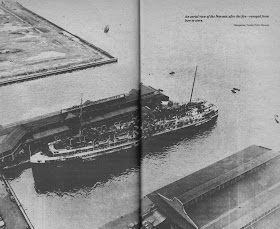I came across this book (published by PaperJacks in 1976) at a book sale in Tweed when out for a motorcycle ride. I had never heard of this terrible tragedy, which happened on the night of September 16, 1949, when the ship was berthed at the bottom of Yonge Street in Toronto.
The S.S. Noronic, at 7000 tons, was the flagship of the Canada Steamship Lines' passenger fleet and had been for many years the largest passenger ship on the Great Lakes. In that era, boat excursions on the Great Lakes were very popular and the Noronic had been built to cater to this trade.
Designed by Eric Tornoos, She was built in 1913 by the Western Dry Dock and Shipping Company of Port Arthur (now a part of Thunder Bay) for the Northern Navigation Company. By the time of her launching, this company had merged with the Richelieu and Ontario Line and several other inland shipping interests to form the Canada Steamship Lines. She was named to commemorate the predecessor lines: NO for the Northern Navigation Company, RO for Richelieu & Ontario, and NIC because this was the suffix that Northern had applied to all of its ships' names (including the Saronic, Hamonic, and Huronic).
 |
| The Grade Teacher, June 1937 |
Designed by Eric Tornoos, She was built in 1913 by the Western Dry Dock and Shipping Company of Port Arthur (now a part of Thunder Bay) for the Northern Navigation Company. By the time of her launching, this company had merged with the Richelieu and Ontario Line and several other inland shipping interests to form the Canada Steamship Lines. She was named to commemorate the predecessor lines: NO for the Northern Navigation Company, RO for Richelieu & Ontario, and NIC because this was the suffix that Northern had applied to all of its ships' names (including the Saronic, Hamonic, and Huronic).
She was beautifully appointed, and basically was the "Titanic" of the Great Lakes.
On the night in question, the Noronic was completing a voyage that had begun in Detroit, so most of the 552 passengers were from Michigan and Ohio. The ship had berthed overnight at Toronto, when a fire started in a linen closet. Through a combination of negligence (based on complacency--remember the Titanic reference?), age (the wood paneling on the vessel was tinder dry, and covered with decades of paint and varnish), design (she was built before fireproof bulkheads were required) and weather (a strong wind was blowing that night, which fanned the flames), the fire quickly spread to engulf the ship. The death toll was terrible: 118 passengers. The fact that none of the 171 crew members were lost was initially celebrated but then criticized--suggesting to many that the passengers had been abandoned to their fate. The book recounts in detail the heroism of some passengers and crew, the selfishness of others, and the valiant efforts of police, firefighters, taxi drivers, hospitals, hotels and the general public to assist the survivors, many of whom were terribly burned.
The remains of the ship were floated and towed to Hamilton to be cut up for scrap. Only the whistle survived, installed in the Marine Museum on the grounds of the Canadian National Exhibition in Toronto (where many of the bodies had been taken for identification. The museum was moved to Queen's Quay in 2000, but has since been closed down.) Canada Steamship Lines paid more than $2 million to next-of-kin of those who had died. The captain was suspended, but retired rather than wait out his suspension, and ended his years working night shift behind the desk of a Sarnia hotel.
 |
| Pierre Berton. Remember Yesterday. A Century of Photographs. The Canadian Centennial Publishing Co. Ltd. ( McClelland & Stewart Ltd.), 1965. |
A plaque was erected at the foot of Bay Street in Toronto to commemorate the tragedy:
The fire spelled the end for Great Lake excursion steamers, although this must have continued for another decade, as suggested by the illustration below in an Ontario basic reader. It accompanied a story about a family's trip on a big lake boat to the Lakehead.
 |
| http://www.torontoplaques.com/Pages_MNO/Noronic_Disaster.html |
The fire spelled the end for Great Lake excursion steamers, although this must have continued for another decade, as suggested by the illustration below in an Ontario basic reader. It accompanied a story about a family's trip on a big lake boat to the Lakehead.







.jpg)



No comments:
Post a Comment